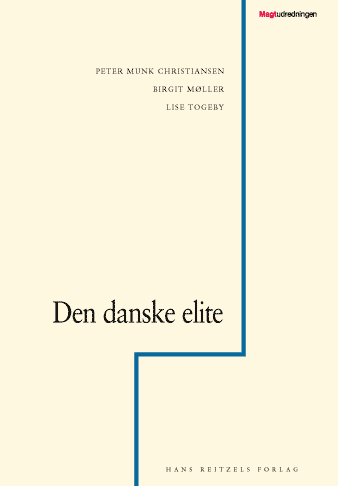Den danske elite
(The Danish Elite)
The Danish Elite by Peter Munk
Christiansen, Birgit Møller and Lise Togeby was published in May 2001.
Hans Reitzels Forlag
284 pages
DKK 225.00
To order, contact a bookshop
|
Although
equality in the Danish society is greater than in most other countries,
Denmark does have its elites. The book analyzes the elites in politics,
administration, courts, organizations, businesses, academia, media and
culture in 1932, 1963 and 1999: the characteristics of these elites, how
the members obtained their elite positions, and changes in the 20th
century.
A
comparison of the whole elite with the population reveals significant
differences. The elite mostly consists of elderly men with academic
degrees, high income, and homes in the posh areas of Copenhagen and
Northern Zealand.
However,
some elite groups differ more from the population than others; judges
probably most so: high average age, law degrees, high income, homes in the
right neighborhoods, born in Copenhagen, and their fathers also belonged
to the elite. The groups that most resemble the judges are the other legal
professions, lawyers and representatives of police and prosecution, but
also officers, scientists and heads of cultural institutions. All these
groups differ markedly from the general population. The groups that are
most similar to the population are union leaders, local civil servants,
local politicians and MPs. |
 |
Business
executives are in many respects placed between the two groups. Their elite
traits are less pronounced than we might expect; relatively few have an academic
degree, and few have fathers that belonged to the elite. However, they are all
men, and especially board chairmen have a high average age. In addition, their
income and fortunes by far exceed the upper limits of other social sectors.
There
are only few women in the elite. In 1999, the average was 12 percent. The
variation is great, though: 37 percent of the MPs are women, but there is only
one woman among the CEOs in the 200 largest companies in Denmark. Between the
two extremes are the different groups of public sector employees: 23 percent of
the senior civil servants in the police and the prosecution are women, 15
percent of the judges, 14 percent of the civil servants, and 8 percent of the
professors. In 1932 there was a total of seven women in Folketinget and Landstinget
combined and two women leaders of the two major female labor unions. They were
the only women in the elite.
Over
time, the distance between the population and the elite has diminished in terms
of gender, age, family background, and probably also education. The distance
between elite and population is still large, but it has decreased.
Self-reproduction
is quite significant in the Danish elite. The chances of ending up in an elite
position increase if ones parents have had elite status. In some elite groups
today, close to 20 percent have parents with identical or similar elite
positions. However, the majority of the elite members have been upwardly mobile,
and they have reached higher positions in society than their parents. Compared
to elites in other countries, the Danish elite thus appears to be fairly open.
It
is clear, on the other hand, that a carefully planned career is a precondition
in most cases for joining the elite. Many elite positions require a degree at a
certain level or starting at the bottom and working ones way up, perhaps
making a switch to a related organization/business. It is rarely possible to
jump from one elite position to another. Decisions made at the beginning of a
career determine the final destination. In this sense, the individual elite
groups are fairly closed. The exception from the pattern is politicians whose
paths to Folketinget are many and
different.
It
turns out that the elites have grown apart during the 20th century. The elites
resemble each other less and the population more than they did earlier in the
century, and the formal networks between persons in different elite groups have
weakened. The elites still have many things in common, and there are relations
across these elites, but especially since the 1960s there has been a trend
towards greater independence in the individual elite groups. There is not one
elite group in Denmark in 1999, rather several more or less autonomous elite
groups with individual functions and recruitment systems.
About
the study
The
1999 study includes 1,540 persons occupying a total of 1,771 top positions in
the Danish society, the 1963 study includes 753 top positions, and the 1932
study 605 top positions. The large majority of these people were selected
because they occupy some of the highest positions in politics, administration,
courts, organizations, businesses, and media. In addition, prominent scientists
and artists were selected for the 1999 study. Information about all these people
is gathered from publicly available sources, such as Kraks Blå Bog. None of the elite persons were interviewed.
[Back]
